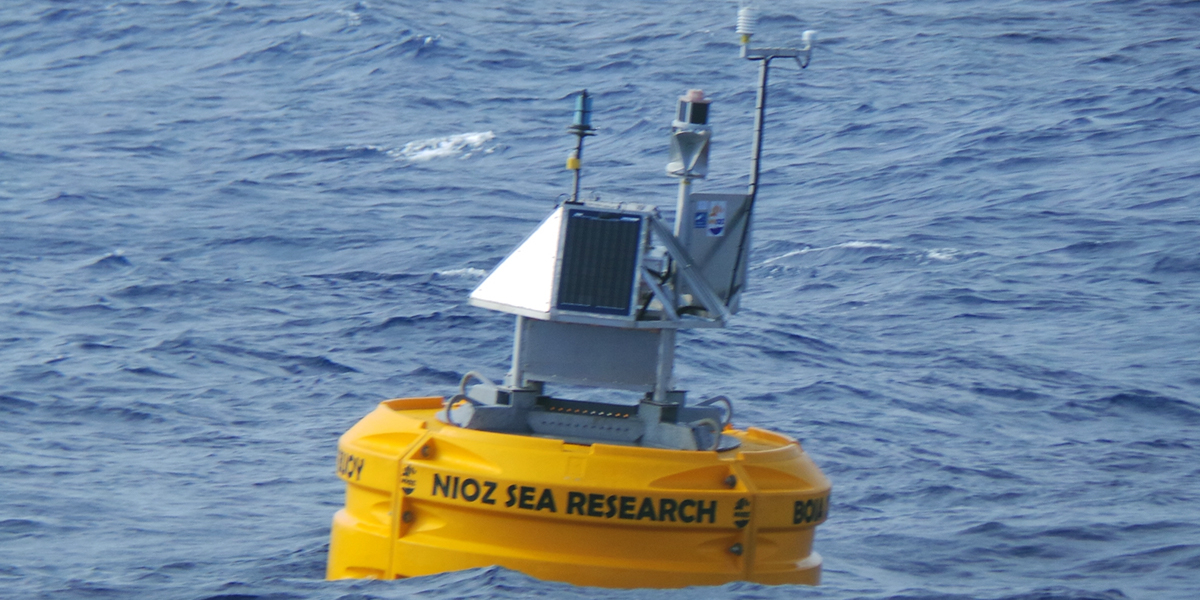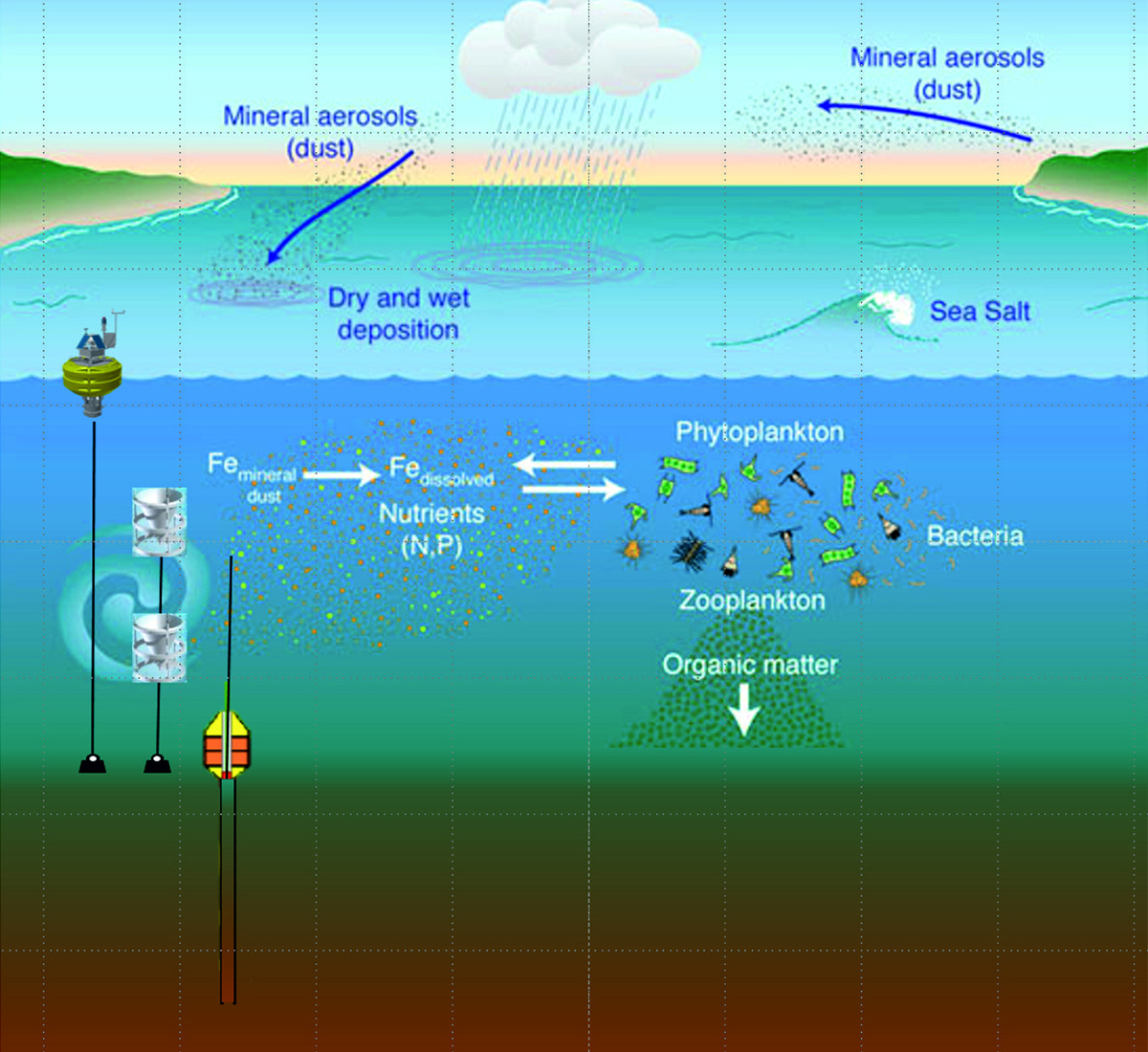Dust-collecting buoys
NIOZ traces dust originating from the Sahara Desert across the whole North-Atlantic Ocean using a trans-Atlantic array of moored equipment. Since 2012 we are monitoring the temporal and spatial variability of Saharan dust transport and deposition and their environmental effects using deep-ocean sediment traps as well as dust-collecting surface buoys developed at the Deep Sea Research Centre by NIOZ technicians. We re-visited these instruments regularly using various research vessels such as NIOZ' own RV Pelagia, but also on foreign ships such as FS Maria S Merian, FS Meteor and RRS James Cook. These instruments are used year-round by NIOZ scientists as well as scientists from other institutes.

General information
Every year, numerous of dust events take place and in total about 180 Million Tons of so-called mineral dust are blown out from the northwest African deserts (including Sahara and Sahel) westward across the Atlantic Ocean. Such amounts of dust deposited over such a big area are likely to have an impact. We are studying Saharan dust by collecting it with instruments that we placed underneath the dust plume.
We deployed tethered dust-collecting buoys with autonomous dust collectors, powered by solar panels, which pump air through filters. In addition, we placed moorings with sediment traps to collect material settling through the ocean. Both dust-collecting buoys and moorings provide time series of dust, as well as marine organic material which we compare with satellite images and meteorological data.
Why are we so interested in Dust?
It turns out that there are many direct and indirect links between dust and climate. The most straightforward one is fine-grained dust in the upper atmosphere blocking incoming sunlight, causing a net cooling effect. But there are warming effects too; in the lower atmosphere, coarser-grained dust particles absorb energy that was reflected at the earth's surface and this way, dust acts as a greenhouse gas. Watch the @NASA video Satellite tracks Saharan dust to Amazone in 3-D. The finding is part of a bigger research effort to understand the role of dust and aerosols in the environment and on local and global climate.
Read more +It always starts with an idea
Technical facilities
In 2012, in close cooperation with the University of Bremen and the University of Miami, the development and construction of dust-collecting buoys started.Video servicing the buoys
The functioning of the measurement instruments is always extensively tested at NIOZ. The construction itself can only be tested if it is in use at its destination.Blog series
Follow the research of Jan-Berend Stuut and his team through the expedition blogs. Read their experiences on chasing and collecting Saharan dust.How may we support you
On the base of a good proposal we develop new or re-newed constructions with solid and high-tech ocean-going instruments. Do you need some advice on the deployment of ocean-going instruments? Or do you want to join us and collaborate with us? Please feel free to contact us. For more details see our publications below this page or visit NIOZ' dustiest webpage: Dust.
Infographic

Contact
Deep Sea & Technology Centre
For all other questions or advice on sea-going instruments, please contact our Deep sea and Technology centre headed by Gert-jan Reichart, head of the Ocean Systems department and Marck Smit, Business Development Manager.
Take a look at our other showcases to get a good impression of our expertise in thinking, developing and implementing applied instruments for an optimal exploration of our oceans.
Publications
-
Korte, L.F., Brummer, G-J A., Van der Does, M., Guerreiro, C.V., Mienis, F., Munday, C.I., Ponsoni, L., Schouten, S., Stuut, J-B W. (2020) Multiple drivers of production and particle export in the western tropical North Atlantic. Limnology & Oceanography DOI: 10.1002/lno.11442
-
Van der Does, M., Brummer, G-J A., Van Crimpen, C.J., Korte, L.F., Mahowald, N.M., Merkel, U., Yu, H., Zuidema, P., Stuut, J-B W. (2020) Tropical rains controlling deposition of Saharan dust across the North Atlantic Ocean. Geophysical Research Letters 47 DOI: 10.1029/2019GL086867
-
Guerreiro, C.V., Baumann, K-H., Brummer, G-J A., Korte, L.F., Sá, C., Stuut, J-B W. (2019)
Transatlantic gradients in calcifying phytoplankton (coccolithophore) fluxes
Progress in Oceanography 176 DOI: 10.1016/j.pocean.2019.102140
-
Stuut, j-B W., De Deckker, P., Saavedra-Pellitero, M., Bassinot, F., Walczak, M.H., Nagashima, K., Murayama, M. (2019)
A 5.3 million-year history of monsoonal precipitation in northwestern Australia
Geophysical Research Letter’ 46 (12), 6946-6954 DOI:10.1029/2019GL083035 -
Van der Does, M., Knippertz, P., Zschenderlein, P., Harrison, R.G., Stuut, J-B W. (2018) The mysterious long-range transport of giant mineral dust particles
Science Advances DOI: 10.1126/sciadv.aau2768 -
Korte, L. F., Pausch, F., Trimborn, S., Brussaard, C. P. D., Brummer, G.-J. A., van der Does, M., Guerreiro, C. V., Schreuder, L. T., Munday, C. I., and Stuut, J.-B. W. 2018. Effects of dry and wet Saharan dust deposition in the tropical North Atlantic Ocean, Biogeosciences Discuss. (in review)
-
Van der Does, M.; Pourmand, A.; Sharifi, A.; Stuut, J-B W. 2018. North African mineral dust across the tropical Atlantic Ocean: insights from dust particle size, radiogenic Sr-Nd-Hf isotopes and rare earth elements (REE). Aeolian Research 33, 106-116 doi:10.1016/j.aeolia.2018.06.001
-
Van der Jagt, H.; Friese, C.; Stuut, J-B W.; Fischer, G. & Iversen, M.H. (2018). The ballasting effect of Saharan dust deposition on aggregate dynamics and carbon export: Aggregation, settling, and scavenging potential of marine snow. Limnology and Oceanography 63, 1386-1394, doi:10.1002/lno.10779 .
-
Schreuder, L.T., Hopmans, E.C., Stuut, J-B W., Sinninghe-Damsté, J.S., Schouten, S. 2018.
Transport and deposition of the fire biomarker levoglucosan across the tropical North Atlantic Ocean. Geochimica et Cosmochimica Acta 227, 171-185 -
Schreuder, L.T., Stuut, J-B W., Korte, L.F., Sinninghe-Damsté, J.S., Schouten, S. 2018.
Aeolian transport and deposition of plant wax n-alkanes across the tropical North Atlantic Ocean. Organic Geochemistry 115, 113-123 -
Guerreiro, C.V., Baumann, K.H., Brummer, G.J.A., Fischer, G., Korte, L.F., Merkel, U., Sá, C., de Stigter, H., Stuut, J.B.W., 2017. Coccolithophore fluxes in the open tropical North Atlantic: influence of the Amazon river and of Saharan dust deposition. Biogeosciences Discuss. 2017, 1-26.
-
Korte, L.F., Brummer, G.J.A., van der Does, M., Guerreiro, C.V., Hennekam, R., van Hateren, J.A., Jong, D., Munday, C.I., Schouten, S., Stuut, J.B.W., 2017. Downward particle fluxes of biogenic matter and Saharan dust across the equatorial North Atlantic. Atmos. Chem. Phys. 17, 6023-6040.
-
Van der Does, M., Korte, L.F., Munday, C.I., Brummer, G.J.A., Stuut, J.B.W., 2016. Particle size traces modern Saharan dust transport and deposition across the equatorial North Atlantic. Atmos. Chem. Phys. 16, 13697-13710.